 WELCOME TO THE CITY OF GUAYAQUIL
WELCOME TO THE CITY OF GUAYAQUIL |
Guayaquil, also known as "The Pearl of the
Pacific", is the capital of the province of
Guayas and is located on the Pacific coast of Ecuador
at an altitude of 4 meters above sea level.
The city is the main seaport of Ecuador and the
economic capital of the country.
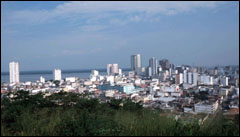
 A THRIVING BUSINESS CENTRE
A THRIVING BUSINESS CENTRE |
Guayaquil's Puerto Marítimo was opened
in 1964 and now handles approximately 90% of Ecuador's
imports and nearly 50% of its exports. The containerized
port of Guayaquil is fully utilized, with ship
turnaround times typically taking five days. The
Port is currently undergoing a modernisation process,
which includes dredging works that will deepen
its capacity and improve its regional position
on the Pacific coast. It will shortly be searching
for a strategic partner on concession basis.
Foreign corporations have been working closely
with the City of Guayaquil. A few years ago the
municipality succeeded in privatizing its potable
water and sewage company, ECAPAG, to International
Water Services for a 30-year period. The new foreign-owned
company, now called Interagua, has been successfully
improving the water services and quality throughout
the city.
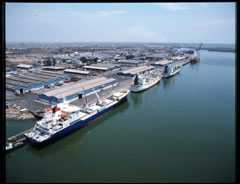
The Airport of Guayaquil is one of the two main
points of entry to Ecuador with International
Airlines arriving on a daily basis from the USA,
Central America, Europe and other countries in
South America. The expansion of its international
terminal is currently being tendered to improve
services and accessibility.
In addition, exploitation of natural gas reserves
(estimated at three trillion cubic feet) in the
Gulf of Guayaquil is under development.
It seems fitting that the magazine "América
Economía" ranked the City of Guayaquil
as the 6th most entrepreneurial city of Latin
America, just behind the cities of Monterrey,
Sao Paulo, Santiago, Bogota and Mexico. The magazine
"Latin Trade" also ranked Guayaquil
in the top ranks of its business destinations.
Mayor Jaime Nebot Saadi has led the charge in
order to attract investment to the region and
to facilitate its expansion. The results-oriented
mayor has transformed the city with his "More
Guayaquil" campaign, which has incorporated
major public works and infrastructure projects
to increase business flow to the city, along with
strong security measures that has increased the
attraction of the city for tourists, business
people and residents alike.
New foundations and business projects include
the following initiatives:
The Foundation for Innovative Companies for
Value-Added Competition (INCOVAL)
This Foundation facilitates and promotes the creation
of profitable companies with a scientific or technological
base, which will incorporate itself in the productivity
channels of the city.
For more information: www.incoval.org
TechnoPark Ecuador
By working with private sector corporations and
universities, this program promises to attract
venture capitalists and create a technopolis in
Guayaquil thanks to its openness to new business
concepts and its international position.
For more information: www.espol.edu.ec
ZOFRAGUA
The Free Trade Zone of Guayaquil is a private
company whose shareholders include the seven Chambers
of Production of Guayaquil. The free trade zone
is situated on the peripheries of the Maritime
Port of Guayaquil, promising to offer duty free
access to service, industry and trade opportunities.
For more information: www.zofragua.org
CORPEI
The Corporation for Promotion of Exports and Investments
is a private entity based in Guayaquil to promote
export programs and the attraction of private
enterprise.
For more information: www.corpei.org
 A NEW TOURIST DESTINATION
A NEW TOURIST DESTINATION |
Tourism is also a major business generator for
the City of Guayaquil, and new infrastructure
projects have helped develop the city into a new
tourism destination of the Pacific coast.
The city is ultimately tropical - temperatures
in Guayaquil remain between 23 and 29 degrees
C. (74 - 85 F.) while the raining season is between
January and May. The influence of the cold Humboldt
currents and warmer currents of El Nino are the
reason why the climate is of a Tropical kind with
summertime ranging from May to December.
The city has a large number of hotels, in the
category of your choice, and excellent restaurants,
bars and other entertainment can be found in this
coastal city.
One of the most ambitious projects was the renovation
of Malecón Avenue. This well known riverfront
includes a number of parks, restaurants, a theatre,
and its purpose it to increase touristic interest.
The city is opening up to tourism through art
exhibits and cultural festivals which promises
to place it on the map of future Latin American
destinations.
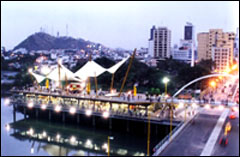
Guayaquil offers travelers a surprising number
of sights and activities. It boasts museums, historic
neighborhoods, sprawling parks and the renovated
waterfront strip, Malecón 2000.
· El Malecón 2000 - is the
recontruction project of the Simóm Bolívar
Pier, one of the most representative sites of
Guayaquil city. The new pier which construction
has already begun, will be one of the most important
civic-touristic-commercial center of South America.
It's turning into the most complete and modern
center of urban recreation of the country. With
multiple green areas of entertainment and commercial
service, it's receiving a significant number of
visitors everyday.
· El Palacio Municipal - sits in
front of the Malecón and holds the political
offices of city and provincial officials. A building
of the neoclassical style, it is considered one
of the most important architectural works in the
country. Employees will enthusiastically answer
questions about the building and are a good source
of information regarding the city.
· Las Peñas Neighborhood - in
the northeast corner of the city's center, is
home to many recognized artists. Many of the area's
400-year-old houses have been converted into art
galleries. A walk through this historic district
gives one a glimpse into Guayaquil's past.
· Mall del Sol - find plenty of
shopping in this new mall, with most of its store
names in English, it will feel eerily familiar
to North American travelers.
· Mercado Artesanal - is the largest
artisan market in the city. The market is housed
in a 240-shop building that takes up the entire
block of Baquerizo Avenue, between the streets
Loja and Juan Montalvo. Its many vendors sell
indigenous crafts, jewelry, paintings, and more!
|
· Parque Centenario - located on
the street 9 de Octubre, between Lorenzo de Garaycoa
and Quito, this is the largest park downtown,
occupying four city blocks. It is a favored place
to take refuge from the equatorial sun. Enjoy
the shade offered by the large trees planted liberally
over the expanses of walkways and lawns. A large
statue of Liberty dominates the central area of
the park.
· Parque Seminario - is not your
typical city park. Seminario, located on 10 de
Agosto Avenue and Chile, is home to dozens of
Iguanas, some of which approach 5 feet in length.
There seems to be hundreds of the monstrous, yet
docile, reptiles lurking all over. Every afternoon,
workers bring fruit and vegetable scraps to lure
the Iguanas from the trees so that onlookers may
watch them descend for a snack! A pond filled
with colorful Japanese Talapia fish and the equestrian
statue of Simón Bolívar located
in the center of the park, are two more reasons
to visit the park.
Entertainment
The city is alive with cultural events which
includes regularly scheduled performances at the
following venues:
· Teatro del Angel - offers live
comedies on weekends. It's located on Balsamos
620 and Ficus in the Urdesa neighborhood.
· Casa de Cultura - on 9 de Octubre
just west of the Parque Centenario, regularly
sponsors film festivals and gives specialized
classes in the arts.
· Malecón Avenue - The new
Pier, which construction has already begun, will
be one of the most important civic-tourist-commercial
sites from South America. With multiple green
areas of entertainment and commercial service,
it's receiving a significant number of visitors
everyday. All sectors have areas of general services,
like restrooms, police departments, first aids
and information stands.
· Urdesa and Alborada neighborhoods
- north of the city's center these two neighborhoods
are known for being polished and preppy, specifically
the street Victor Emilio Estrada in Urdesa and
"Calle Principal" in Alborada. Both
boast numerous restaurants, shops, cafes, and
bars.
Northern Guayaquil
The Barrio las Peñas located at the foot
of the Santa Ana hill is an area of the city with
a coastal colonial architecture. It was destroyed
and reconstructed several times as a consequence
of fires, in particular the great fire of 1896.
It has only one street called Numa Pompilio LLona
in honor of a famous Ecuadorian man of letters.
This street starts at the Planchada wich was the
place from which the city was defended and ends
at the old installations of the Brewery, one of
the Guayaquil's first industries.
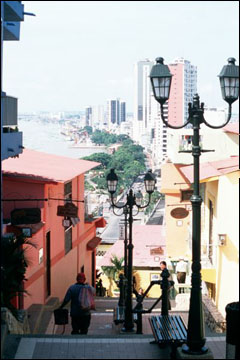
During the festivities conmemorating the foundation
of the city, this area becomes the city of outdoor
exhibitions where national as well as foreign
artists expose their works. Today many of the
houses along this street have been turned into
a galleries. It is here that many well know poets,
heroes and composers such as Antonio Neumane,
the author of the music of our national anthem,
were born.
The Church of Santo Domingo, also known as the
Church of Saint Vincent was the first church of
this city, built in 1548 and reconstructed on
several occasions because of fires. The Basílica
de la Merced, San Francisco and the Metropolitan
Cathedral should also be visited.
Downtown Guayaquil
The Malecón Simón Bolívar,which
runs along the River, is also called the Paseo
de las Colonias (the Promendade of the Colonies).
It has its beginning at the Avenida Olmedo where
the statue of José Joaquín de Olmedo,
an eminent citizen who fought for the Independence
of Guayaquil, stands in a park which bears his
name.
The public clock (Moorish Tower)was destroyed
by the tides as its base was made of wood. It
was rebuilt in 1930, on the same spot. It is a
Moorish style tower. The purpose of this clock
was not a only to call the people to pray but
also to alert the population against pirat attacks
or to call for help in case of any need.
Municipal Palace, (City Hall)of neoclassic style
is considered one of the best architectonic works
of the city; and the Parque Sucre which separates
it from the Ministry of the Interior Building,
the Gobernación , which is a combination
of variety of styles.
The Hemiciclo de la Rotonda where a great marble
and bronze statue is erected, conmemorating the
meeting between two great liberators in America:
Simón Bolíivar and José de
San Martín.
Parque Centenario a beatiful park in the middle
of the city with 200 meters where the Column of
October or of Liberty stands, designed by the
Spanish sculptor Agustín Queirol in 1918.
On each side of its base are the statues of Olmedo,
Febrés Cordero, Villamil and Antepara,
men who distinguished themselves in the struggle
for the independance of Guayaquil. On each angle
of the pedestal there are statues which represent
History, Patriotism, Heroism and Justice and on
top of the Column there is a statue with an outstreched
arm holding a torch.
The main hotels of the city are located in the
downtown touristic center of the city. They all
offer an excellent service which will make your
stay in Guayaquil very pleasant and you will not
doubt to return some day.
Southern Guayaquil
Parque España located facing the Temple
of the Sacred Heart of Jesus; in its center stands
the statue of Sebastían de Benalcázar,
the founder of San Francísco de Quito;
Parque de la Armada, here lies the Calderón,
a gunboat which played an outstanding role in
the naval battle of Jambelí in 1941 and
which now contains a historical museum. The Centro
Cívico Theather; the planetarium of the
Navy and Puerto Marítimo, one of the most
important ports of South America on the Pacific
Ocean where ships from all over the world dock.
The Surroundings
The Botanical Garden is located at the foot of
the Cerro Colorado hill at Francisco de Orellana
Avenue. Here you can find three thousand varieties
of vegetable species including hundred and fifty
varieties of orchids.
If you like excursions, we should like to recommend
a visit to Cerro Blanco. Situated on Km 15 on
the coast road it is a representative sample of
a tropical dry forest and constitutes an important
refuge for more than hundred and ninety species
of land birds and six species of sea birds.
Puerto Hondo, 17 kilometers away on the road to
the coast, we come upon this reserve of mangroves,
where we can appreciate the ecosystem of the magrove,
opposite to it is an archeological site called
Palombamba where in general fairly well preserved
archeological finds have been made and which correspond
to the Huancavilca culture.
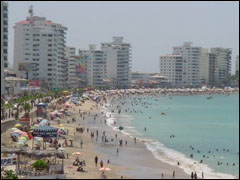
Taking a closer look at what the province of
Guayas has to offer, you will find great beaches
as Salinas, Montañita, Punta Blanca, Playas
(General Villamil), and Puntas Arenas; many in
which you can practice water sports.
For more information, the City of Guayaquil is
at your disposal at http://www.guayaquil.gov.ec/
|

